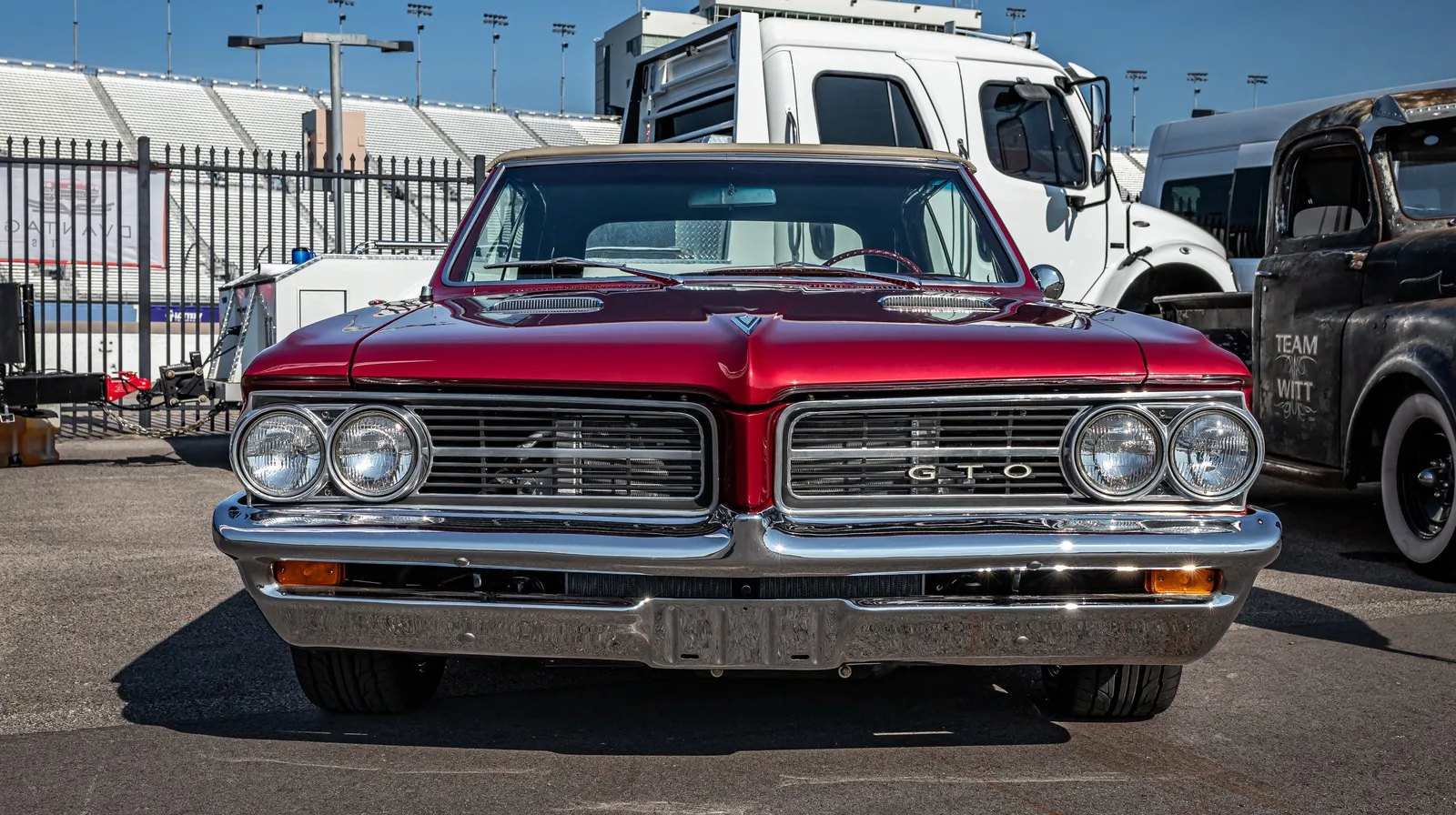
Future Muscle: The 1964 Pontiac GTO
In October 1963, General Motors made an announcement that would change the American automotive landscape. The company revealed the GTO sport option package for the 1964 Pontiac Tempest. While some assumed it might simply be a cosmetic trim level, the GTO was much more than that. Yes, it included stylish touches like bucket seats, unique GTO badging on the instrument panel, and decorative hood scoops. But the real magic was under the skin: the GTO transformed the modest mid-sized Tempest into a powerful machine built for speed, performance, and a bold new attitude.
One Pontiac sales brochure captured the spirit perfectly, describing the GTO as “a device for shrinking time and distance.” That description was not just marketing hyperbole—it was a statement of intent.
The GTO package signaled Pontiac’s determination to build a car for enthusiasts who craved raw power and thrilling acceleration. It was arguably the first true American muscle car, a category of automobile that would dominate car culture throughout the 1960s and 1970s. Nearly six decades later, the GTO’s reputation remains untarnished, its legacy celebrated by collectors and performance fans alike.
The 1964 brochure was blunt about the car’s mission: “Designed as a piece of performance machinery, its purpose in life is to permit you to make the most of your driving skill. If you start vibrating when you’re at the controls of a sudden automobile, if you’ve driven enough kinds of performance to know what it’s all about, then you’ve got GTO written right across your forehead.”
Borrowing a Name with Swagger
The GTO name itself carried weight. Short for Gran Turismo Omologato—Italian for “grand touring homologated”—it was a term associated with cars approved for international racing by the FIA. At the time, Ferrari’s 250 GTO was one of the world’s most coveted machines, a rare and elegant racing-bred sports car. By adopting the GTO name, Pontiac made a bold, almost cheeky challenge: an American car that could bring exotic-sounding performance thrills to everyday drivers at a fraction of the price.
To put it in perspective, Ferrari’s 250 GTO cost about six times more than a Pontiac GTO when both were new. Today, Ferraris from that era have sold at auction for as much as $70 million, making them unattainable for all but the wealthiest collectors. Pontiac’s decision to borrow the name wasn’t just clever branding—it was a declaration that Detroit could compete in the performance game, even against Europe’s most prestigious manufacturers.
Performance that Matched the Hype
The first GTOs rolled off production lines in late 1963. Under the hood sat the 389 cubic-inch V8 engine, borrowed from the larger Pontiac Grand Prix. It produced 325 horsepower in base form, with optional upgrades pushing output even higher. Paired with features like a Hurst four-speed shifter and triple two-barrel carburetors—known as “three deuces”—the GTO delivered the kind of performance drivers had previously only dreamed about.
The car even became immortalized in pop culture. Ronny and the Daytonas’ surf-rock single “G.T.O.” hit number four on the Billboard Hot 100 in September 1964. The lyrics celebrated the car’s standout specs: the triple carburetors, the four-speed manual, and that iconic 389 V8. Few cars had the honor of being turned into a chart-topping hit, but the GTO was no ordinary car.
The DeLorean Factor
Much of the credit for the GTO belongs to John DeLorean, then Pontiac’s chief engineer. Long before he founded his own car company and produced the stainless-steel, gull-winged DeLorean DMC-12, DeLorean was shaking up GM. He pushed the idea of dropping the large 389 engine into the mid-sized Tempest, a move that broke from GM’s corporate restrictions on engine sizes for smaller cars.
As automotive PR veteran Jim Wangers recalled in his book Glory Days: When Horsepower and Passion Ruled Detroit, DeLorean not only spearheaded the project but also personally drove the prototype. He often loaned it to friends, only to struggle to get it back, a sign of how irresistible the car had become even in its earliest days.
From the “Tiger” to the “Goat”
Pontiac’s marketing leaned heavily on animal imagery, often comparing the GTO to a tiger. But enthusiasts came up with their own nickname: “the Goat.” Long before the acronym GOAT stood for “Greatest of All Time,” it was simply a playful shorthand that reflected the car’s rugged, muscular personality.
One publicity coup cemented the GTO’s reputation. In 1964, Wangers persuaded Car and Driver magazine to run a comparison between the Pontiac GTO and Ferrari’s celebrated 250 GTO. While the matchup may have been more symbolic than direct, the article gave Pontiac credibility with even the harshest automotive critics. The car wasn’t just a marketing stunt—it delivered real performance.
Rise, Fall, and Revival
The GTO’s success was immediate. By 1966, Pontiac elevated it from a Tempest option package to a standalone model. But fortunes shifted as the muscle car era waned. In 1972, the GTO reverted back to being an option package, and by 1974, amid rising fuel prices and the oil embargo, Pontiac discontinued it entirely.
The GTO wasn’t gone forever, though. In 2004, GM resurrected the nameplate in the U.S., importing a rebadged version of the Holden Monaro from its Australian division. While the modern GTO offered strong performance, it lacked the distinctive character of the original and lasted only until 2006. Still, the attempt showed that the GTO name retained powerful recognition decades after its debut.
An Enduring Icon
Though the Pontiac brand itself is no longer around, the legend of the 1964 GTO endures. It remains a cornerstone of muscle car history, a symbol of a time when Detroit dared to challenge the world with unrestrained horsepower. From its audacious name to its rumbling V8, the GTO proved that performance could be democratized, not just reserved for European elites.
Six decades later, the GTO continues to inspire nostalgia, admiration, and respect. For many, it wasn’t just a car—it was freedom on four wheels, and a signal that America’s car culture had truly come of age.




